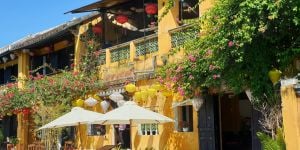
Characterized by rivers of motorbikes and waves of roaring horns, Vietnam's capital city promises an unparalleled charm and intrigue within moments of arriving. A collage of conical hats (known as Non-La), food hawkers, and motorbikes transporting almost anything imaginable, paints a remarkable picture and defines the truly magical aura. A welcome mat of helpful locals and tantalizing smells can be expected within moments of stepping outside the airport. However, this is just the tip of the Hanoi iceberg!
Good to know:
Arriving at Hanoi's Noi Bai airport is as pleasant as any other city. Provided all documents are in order, getting through immigration will typically take less than an hour. Take a look at our article about Visas for Vietnam and make sure you have everything prepared.
The history of Hanoi
Hanoi is the capital city of Vietnam and one of the oldest capitals in the world. It's known for its centuries-old architecture, rich history, and bustling street life. The city is divided into different districts, each with its unique charm. One particularly endearing part about Hanoi is the Old Quarter, where you can drink at Bia Hoi's like a local, or find a street dedicated to decorations, or sneakers! The Old Quarter contains many historical sites that are well preserved among the energy and hustle of tourists and citizens.
Noteworthy spots for everyone to visit during their time in Hanoi are:
The Ho Chi Minh Mausoleum: visitors can pay their respects at the final resting place of Ho Chi Minh, the Vietnamese revolutionary and politician who united the country and served as its first democratic president. We encourage you to check the schedule ahead of time because, due to certain events, you may not be allowed inside.
The Temple of Literature: This is Vietnam's first university, dating back to 1070. While small in size, it contains a magnitude of ancient architecture and texts while surrounded by well-manicured gardens. The doorway to this temple is incredibly small, and you may miss it as you walk by!
The Hoa Lo Prison: Referred to as the "Hanoi Hilton" during the Vietnam War, this prison tells a story of the country's turbulent history and includes staged recreations of what American POWs would have lived in.
Hanoi Train Street: You've definitely seen this on social media with tiny cafes and bars moving their patrons away from the tracks as a train goes through the bustling alley. It is well patrolled by police, and the best advice we can give you is to listen to the cafe and bar owners when they tell you it's time to move!
The dialect and differences in Hanoi
If you're planning to stay in Hanoi for a while, learning a few of the basic phrases will serve you well. Regardless of the country you visit, you can't go wrong with the good old “Hello” and “Thank you”:
- Hello - Xin chào (pronounced ‘seen chow'),
- Thank you - Cảm ơn (pronounced ‘gum on').
Things can get a little complicated in Vietnam for numerous reasons. Firstly, pronouns are a fundamental aspect of the language, and they change depending on the person you are talking to. One of the reasons for using pronouns here after making a statement is to show courtesy. Don't worry about getting this stuff right at first. It takes practice!
To complicate life a little more, the Vietnamese language differs somewhat between the north, central, and south. Basic phrases are still the same; however, nouns, pronouns, and the pronunciation of consonants vary massively.
Hanoians will be super impressed if you arrive already aware of the difference between the southern and northern dialects. The capital city prides itself on being the best or preferred way to speak Vietnamese, even though there are different dialects in central and southern Vietnam. All three regions have a different number of tones they use to express words, and misusing a tone can change a sentence entirely. The Northern dialect contains six tones, and the South and Central both have five, which are also different.
If you think a simple tone change can't be that big of a deal, check out these fun examples: bạn trai (boyfriend) or bàn chải (toothbrush) or bạn (friend) versus bàn (table). Another slight difference in words is from items like a t-shirt or pork belly, two important ingredients in becoming comfortable in your new life in Hanoi. People in the north pronounce t-shirt as áo phông, and in the south, they say áo thun. In the north, pork belly is ba chỉ, while in the south it's ba rọi.
If you are looking for a way to practice or expand your knowledge before arriving in Hanoi, Duolingo is set to Northern dialect tones and can help you out in a pinch with no problem!
The climate in Hanoi
One of the main things that distinguishes the capital from Ho Chi Minh City in the south is the weather! Hanoi has seasons, and residents can feel the shift from the summer humidity to the plummet in temperatures of winter. In between, you can compare the mid-range temperatures to a spring or fall ambiance. If you are planning to relocate to Hanoi, keep in mind that you should pack those jumpers, hats, and gloves you thought you could leave behind by moving to a tropical climate! Here's a closer look at the seasonal breakdown:
Spring is only for one month!
Spring in Hanoi takes place from March to April and is categorized by an uptick in mold on almost all your damp winter belongings! We guarantee you will become a pro quickly on the tricks and tips to mold-proof your home and belongings, and it's a great conversation starter with neighbors or new friends at your local. Temperatures range from 15°C to 25°C (59°F to 77°F), and you may still experience a light shower to keep the blooming flowers and greenery lush. This is a great time for visitors as pollution is also lower and mitigated by the lower temperatures and occasional rain.
Summer of love or for four months of blistering heat!
Summer in Hanoi is hot and humid. Temperatures can soar up to 35°C (95°F), and humidity levels are high. This season coincides with rainy forecasts, and heavy showers, thunderstorms, and even landslides are common. If you are moving to Hanoi during this time, we recommend taking care of admin or physical tasks first and then finding the closest pool to spend the remainder of your day.
Fall is a treat with hearty Vietnamese soups and stews on every corner
Taking place from September to November, the weather is cooler and more comfortable during the fall, with temperatures ranging from 20°C to 30°C (68°F to 86°F). The city is less humid, and the skies are often clear. It's a great time to explore outdoor attractions or take one of the day trips we've listed below.
Winter and experiencing snow or frost in Southeast Asia
The first winter you spend in Hanoi will be colder than you expect. While the “fall” months should begin to prepare you, it's still a shock to the system, and we won't blame you if you flock down south to find the sun! Temperatures can drop as low as 6°C (43°F)- 10°C (50°F), but for some, these colder days complete the mystical charm of the atmosphere.
Transportation in Hanoi
When you arrive at Noi Bai Airport, we encourage you to book a Grab taxi instead of taking a cab that's waiting outside. The airport is quite a journey from the city center and provides the perfect opportunity for tourists or new expats not yet familiar with the currency to lose some during a high meter or a stubborn driver. Alternatively, if you are packing lightly, Grab bikes aren't allowed into the airport arrivals, but you can easily walk through the parking lot to the waiting bike parking outside the airport.
Traffic in Vietnam is a different beast, and we understand if you don't want to rent a motorcycle right away. However, for those who are comfortable driving, your hotel or colleagues are a great place to find a reliable rental and mechanic service. There are more than 5 million registered motorbikes in this city, so this method of travel is a clever way of blending in. Just be prepared to see bikes stacked with entire families, livestock, or various exotic plants and animals, and the culture shock will turn into anecdotal stories to share with loved ones.
Hanoi is in the process of building its metro system and currently has two active lines. You can read more about the transit developments at Vietnamnet and also look into the future plans for green zoning where Hanoi hopes to block any motorcycles or trucks.
Important:
When you cross the street, remember that the people of Hanoi drive on the right-hand side of the road, and to either wait for a traffic light signal or check your blind spot religiously. If crossing a busy intersection, raise one arm and walk slowly and confidently across the road. Stopping or hesitating will confuse drivers attempting to adjust to going around you.
The driving culture in Hanoi
Driving in Vietnam is somewhat different from driving in other parts of the world. It definitely appears a little less organized, and honking is rampant. Hanoi is a sprawling big city that mixes old-world elegance and new-age enthusiasm in everything from buildings to art and neighborhoods.
Due to the congestion, getting from one place to another normally takes a while, and if you are attempting to drive, remember to stay defensive yet offensive at all times. If you drive on the right side of the road and away from the center lanes, it will be slower, and people will understand you are learning. People generally don't let others go first, and overtaking the driver in front of you or cutting in line at a grocery store will quickly make you realize why the confidence to fight for your position is necessary. Don't let this give you the wrong impression of the locals; they are generally pleasant and helpful, but on the road, well, everyone is trying to get to point B as quickly as possible.
As mentioned above, the locals are even moderately polite during times of chaos. This is signified by the duration of the horn noises. A rapid succession of honks implies 'I'm coming; please move to the side', whereas a long, singular honk means “Get out of my way now!”.
If you are ever on foot in this exciting city, there are many important things to keep in mind. When using a pedestrian crossing, do it in a slow but confident manner and never run. Drivers will maneuver around you, and we encourage everyone to adhere to stop lights and walking signals when applicable. Be aware of cars flashing their lights at you at night if you are crossing a road. In the UK, for example, this is an invitation to cross the road before they continue, but in Hanoi, this has the opposite meaning. Do NOT proceed to cross the road if a driver has flashed their lights, as they have indicated they have no intention of stopping for you!
Safety in Hanoi
One of the first misconceptions about this incredible city is that danger lurks around various corners and small alleys. When you move to Vietnam, you'll experience the joy of discovering the best food or hidden spots and won't think twice about strolling towards the smells wafting your way.
Hanoi does have a relatively high rate of traffic accidents, most of which typically result in nothing beyond cuts and bruises. Other safety concerns for new expats or visiting family members would include pick-pocketing in heavily populated tourist areas and fake tour operator scams.
Unlike the rest of the country, Hanoi still enforces a noise curfew in many areas. Legally, this is found under Circular No. 39/2010/TT-BTNMT and was implemented by the Ministry of Natural Resources and Environment in 2011. It can be witnessed mainly with bars in the old quarter closing by midnight or pulling down a gate and blocking the inside view from the street. This curfew is meant to improve the quality of life for residents and is only in place for business operating hours and to control noise pollution.
The curfew only impacts you as an expat if you choose to stay in a bar open after 12 AM. You will see a gate pulled down or the crowd encouraged to come inside if they have been on outdoor seating. Staff will help you leave the building by pulling up or opening gates that have been closed to present the illusion of following the bylaw. In foreigner-dense districts like Tay Ho or Hoan Kiem, venues are legally open until 2 AM on weekends.
Smart dos and don'ts in Hanoi
Although Hanoi is an incredibly safe city, violent crimes are almost unheard of - you are encouraged to take the necessary precautions. Pickpocketing and sexual assault are two of the highest crimes. We encourage you to use the buddy system if possible while learning your new environment. Below are a few dos and don'ts that you should try to apply at all times.
Do
Carry only what you need to. That includes just enough cash for the activities you wish to indulge in and a copy of your passport rather than the real thing. A picture on your cell phone will suffice as long as your visa stamp information is visible.
Carry a business card or the address of the hotel or accommodation where you are staying at all times. This will be far easier than trying to pronounce the street name to any taxi driver.
Dress comfortably yet modestly. When wearing shorts during the day, you may still get a few looks, but that is because the Vietnamese don't like the sun to touch their skin at all. You'll see people covered head to toe during the day, but at night, wearing tank tops, skirts or shorts don't even get a second look. Please do not wear bathing suits while exploring the Old Quarter as a measure of respect to the locals who live there.
Take your shoes off at any home, and follow the lead of others in certain stores.
Don't
Wear large amounts of expensive jewelry in public as it is considered impolite to flaunt wealth in such a blatant manner.
Take photographs of government houses, police stations, or military bases.
Wear revealing clothing when visiting temples, pagodas, or religious attractions.
Show too much affection for your partner in public, regardless of gender. Vietnam is a safe space for LGBTQIA+ couples, but as a general rule, large displays of affection make people uncomfortable. For example, holding hands or linking arms will not ruffle any feathers, but passionately kissing on the side of the street might get an aunty sweeping you away from her establishment.
Food in Hanoi
There is a long-running argument as to who has the better food in Vietnam - the North or the South - so we encourage you to try as many local dishes as possible! Hanoi is known for Chicken Pho, Bun Cha, and hearty rice porridge to combat the colder winter months. You'll have lots of opportunities to eat from food hawkers on the street and try out different toppings on multiple banh mi's. Anthony Bourdain, a famous American chef and author, praised the food and creativity scene in Hanoi while speaking about his love for Vietnam as a whole, especially for food vendors' preference for fresh and flavorful ingredients. With so many hidden alleyways and neighborhood gems, you can easily try the same food five times and have it five different ways.
As you travel through the country, you'll realize many staple dishes are similar but presented or prepared with a local flair or twist. For instance, banh xeo (crispy, stuffed rice pancake) in Hanoi is smaller than what is served in the south, and bun cha (grilled fatty pork on top of white rice noodles and herbs with a side dish of salty spicy dipping sauce) is served with additional bowls in the south versus a simple two-bowl meal in the north.
There are also plenty of foreign cuisines and restaurants in the capital city, with prices ranging from a few dollars per meal to over a hundred for a more extravagant three-course meal.
Day trips from Hanoi
While there are tons to see and do within the Hanoi city limits, some of the best day trips are only a short bus ride away. Only a couple of hours from the city will transport you into nature with lush green landscapes and exciting motorcycle routes. Here are a few popular day trips:
Ninh Binh
This two-hour journey from Hanoi is often referred to as "Ha Long Bay on land" and is renowned for its stunning landscapes of limestone karsts and winding rivers. While you're there, you'll hop on a long-canoe style boat and see natural caves, pagodas, and the UNESCO World Heritage Trang An. One day, exploring these rivers will give you a fresh perspective on city living and provide a well-deserved respite from pollution or chaotic city streets.
Ba Vi National Park
Only an hour and a half away, the national park is breathtaking with hiking trails, hot springs, bee farmers, and even a zoo! Definitely a family-friendly day outing, and you can rent a driver for the day or find a group of friends and make it a motorcycle rally!
Halong Bay
Technically, Halong Bay is just a two-and-a-half-hour journey from Hanoi, but this really should be a place you experience for longer than twenty-four hours. If you are strapped for time and need to make the most out of a quick itinerary, it's completely possible to see the UNESCO World Heritage site in one day. The Bay offers day cruises that will hit all the key points and showcase the stunning emerald waters and limestone islands, one of the most recognizable features. However, on a day trip, you won't be able to see the sunrise or sunset crest across the water or explore the quaint port town that houses all the boats and tour operators.
We do our best to provide accurate and up to date information. However, if you have noticed any inaccuracies in this article, please let us know in the comments section below.








